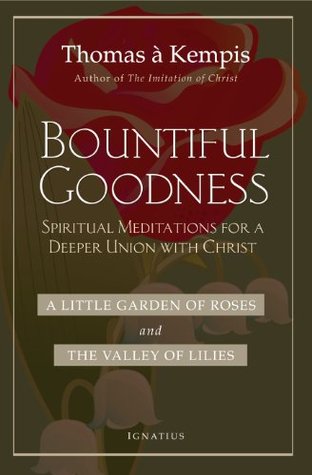- Bible
- Read the Bible
- Bible Versions
- Verse of the Day
- Reading Plans
- Verses by Topic
- Books of the Bible
- Bible Images
- Study
- Commentaries
- Concordances
- Dictionaries
- Encyclopedias
- Sermons
- Bible Atlas & Maps
- BP Wiki
- Devotionals
- Today's Devotionals
- Light of the World
- All Devotionals
- Inspirational Quotes
- More
- Picture Quotes
- Videos
- Inspirational
- Bible Study
- What The Bible Says
- Bible Q&As
- Daily Bread
- Bible by Genre
- Bible Stories
- Random Bible Verse
- Community
- Store
Bountiful Goodness: Spiritual Meditations for a Deeper Union with Christ
The Imitation of Christ, also by Thomas À Kempis, is the most famous and beloved Christian devotional ever written. The simplicity, piety and wisdom that readers have found in that classic will also be discovered in these new modern-English translations of A Little Garden of Roses and The Valley of Lilies. The aim of these works is to draw the reader to a closer union with Jesus. While Imitation sets forth the principles of discipleship, the two works in this volume offer more practical advice. They treat of the virtues needed to advance toward God.
The Imitation of ChristThe Imitation of Christ, also by Thomas À Kempis, is the most famous and beloved Christian devotional ever written. The simplicity, piety and wisdom that readers have found in that classic will also be discovered in these new modern-English translations of A Little Garden of RosesA Little Garden of Roses and The Valley of LiliesThe Valley of Lilies. The aim of these works is to draw the reader to a closer union with Jesus. While ImitationImitation sets forth the principles of discipleship, the two works in this volume offer more practical advice. They treat of the virtues needed to advance toward God.The introduction to this volume includes a brief biographical sketch of Thomas À Kempis, a fourteenth-century German monk, as well as some notes about the texts themselves. Like all meditation books, explains the introduction, this one is not to be read in one sitting, but pondered and prayed over slowly. "Pause and reflect on what [À Kempis] has to say," advises Fr. Joseph Tylenda, the translator, "and then join with him when he address the Lord and listen to Him when He speaks to you."
The introduction to this volume includes a brief biographical sketch of Thomas À Kempis, a fourteenth-century German monk, as well as some notes about the texts themselves. Like all meditation books, explains the introduction, this one is not to be read in one sitting, but pondered and prayed over slowly. "Pause and reflect on what [À Kempis] has to say," advises Fr. Joseph Tylenda, the translator, "and then join with him when he address the Lord and listen to Him when He speaks to you."BUY NOW
Published by Ignatius Press (first published September 17th 2013)

Thomas a Kempis (1380 - 1471)
Was a canon regular of the late medieval period and the most probable author of The Imitation of Christ, which is one of the best known Christian books on devotion. His name means "Thomas of Kempen", his hometown, and in German he is known as Thomas von Kempen. He also is known by various spellings of his family name: Thomas Haemerken; Thomas Hammerlein; Thomas Hemerken and Thomas Hämerken.His first tenure of office as subprior was interrupted by the exile of the community from Agnetenberg (1429). A dispute had arisen in connection with an appointment to the vacant See of Utrecht. Pope Martin V rejected the nomination of Bishop-elect Rudolf van Diepholt, and imposed an interdict. The Canons remained in exile in observance of the interdict until the question was settled (1432). During this time, Thomas was sent to Arnhem to care for his ailing brother. He remained there until his brother died November, 1432. Thomas spent his time between devotional exercises, composition, and copying. He copied the Bible no fewer than four times,[3] one of the copies being preserved at Darmstadt, Germany in five volumes. In its teachings he was widely read and his works abound in Biblical quotations, especially from the New Testament.
Thomas a Kempis was a late Medieval Catholic monk and probable author of The Imitation of Christ, one of the best known Christian books on devotion.
His writings are all of a devotional character and include tracts and meditations, letters, sermons, a life of Saint Lydewigis, a Christian woman who remained steadfast under a great stress of afflictions, and biographies of Groote, Radewijns, and nine of their companions. Works similar in content to the Imitation of Christ, and pervaded by the same spirit, are his prolonged meditation on the life and blessings of the Savior and another on the Incarnation. Both of these works overflow with adoration for Christ.
... Show more